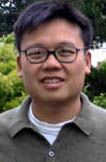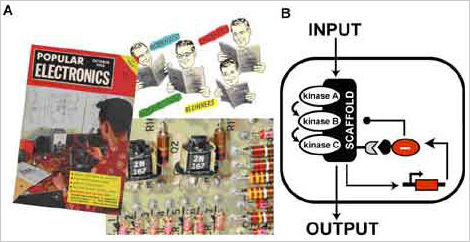
Wendell Lim
A team of UC San Francisco scientists, in work published in the March 14 issue of
Science, have shown how a toolkit of modular molecular components and circuit boards can be used to engineer a wide variety of biochemical circuits in living cells, much as the old Heathkit electronic kits of the 1950s enabled students and hobbyists to assemble modular electronic parts into working radios and computers.
The work is part of the growing field of synthetic biology, in which scientists are trying to learn how to engineer cells to help solve medical, industrial, and environmental problems. Supported by grants from DARPA, the NIH, and the University of California, the work was carried out in UCSF's Department of Cellular and Molecular Pharmacology and in the California Institute of Quantitative Biosciences (QB3) by graduate student Caleb Bashor, lead author on the work, postdoctoral fellows Noah Helman and Shude Yan, and Professor Wendell Lim, senior author on the work. Lim is a participant in the Synthetic Biology Engineering Research Center (SynBERC), an NSF-funded center headquartered at UC Berkeley that also involves researchers at UCSF, MIT, Harvard, and Prairie View A&M University.
Many of the behaviors of living cells are determined by circuits composed of proteins known as kinases, which are found in organisms ranging from yeasts to plants to humans. These proteins can transmit information via a molecular signal known as phosphorylation. Kinase circuits can determine how a cell will respond to signals in its environment, and are used to control cell growth, differentiation, and immune response.
Precisely how kinase molecules are wired together determines how a cell will respond. In many cases, specific kinase components are wired together in a specific arrangement by molecules known as scaffolds. These scaffolds operate essentially as molecular circuit boards, analogous to the circuit boards from electronic kits in that they bind and organize the wiring between individual molecular components.
 |
A: Early in the electronics era, hobbyists and students used kits consisting of circuit boards and electronic components to build diverse devices. B: UCSF scientists have invented an analogous approach that may enable the custom reprogramming of cells for diverse therapeutic and biotechnological applications. In this kinase circuit, the protein labeled as "scaffold" acts as the molecular circuit board. |
Lim's group showed that they could take an existing kinase circuit, and rationally modify it by engineering this molecular circuit board. Using molecular genetic methods, they were able to add new binding sites to the scaffold protein, thus systematically changing the underlying molecular circuit board. They can then insert a variety of new molecular components to amplify or dampen the circuit, or to achieve other specific effects. By combining these components in unique ways, they can build a wide variety of cells that filter and process incoming signals in distinct ways, exactly as electronic devices can do.
"This work tells us a lot about the organization of biological circuits," says Lim, "and how the complex and diverse molecular circuits that we find in living cells might have evolved in a rather simple stepwise manner." This work also has important implications for engineering cells, according to Lim. "It shows that we can rationally modify cellular kinase circuits," he says. Although the circuits that these researchers are tinkering with are fairly simple, it is possible such approaches will help lead to future applications such as engineering therapeutic stem cells with custom programmed behavior or cells that can manufacture drugs and biofuels in a highly controlled manner.
Using Engineered Scaffold Interactions to Reshape MAP Kinase Pathway Signaling Dynamics
Caleb J. Bashor, Noah C. Helman, Shude Yan, Wendell A. Lim
Science, 14 March 2008
Abstract |
Full Text | Full
Text (PDF) |
Related Links:
Wendell Lim's lab
Synthetic Biology Engineering Research Center (SynBERC)

